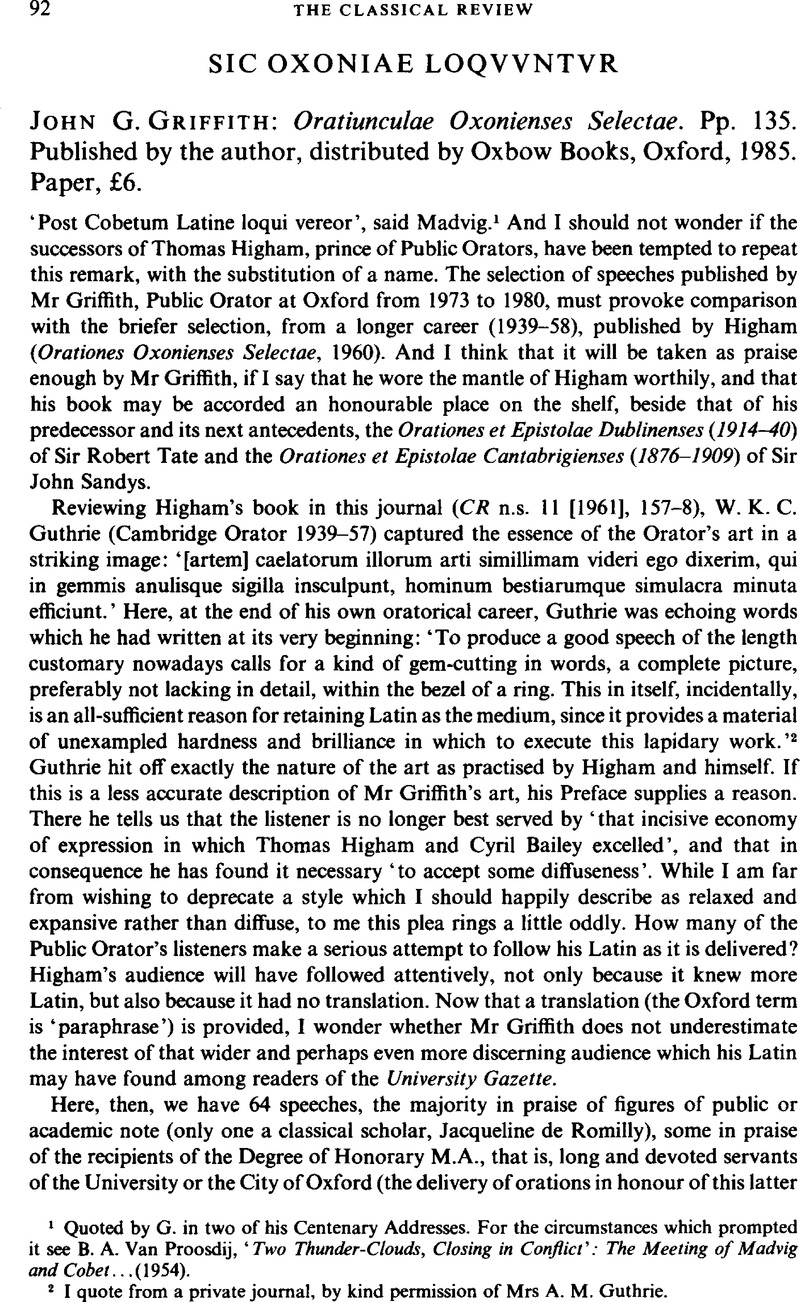No CrossRef data available.
Published online by Cambridge University Press: 16 February 2009

1 Quoted by G. in two of his Centenary Addresses. For the circumstances which prompted it see Van Proosdij, B. A., ‘Two Thunder-Clouds, Closing in Conflict’: The Meeting of Madvig and Cobet… (1954).Google Scholar
2 I quote from a private journal, by kind permission of Mrs A. M. Guthrie.
3 Before taking leave of parochial quibbles, I observe that a Cambridge Orator has claimed for his own University the story (p. 106) of the Proctor's Bulldog who protested to an undergraduate that, if he did not run faster, he would have to catch him: see Wilkinson, L. P., Ovid Recalled (1955), 199.Google Scholar
4 Let me draw attention to the entertaining article in which Higham lists the Ovidian quotations which he has put to such use: G&R n.s. 5 (1958), 13–15.
5 Although metre forbids it here, Aeneam ought to be Aenean (see Housman, Classical Papers 830–3). Similarly, we want Thucydiden not -em (pp. 32, 92 [incidentally, the middle name of this honorand is not William but Wentworth]), and Apellen not -em (p. 104) (Housman, 824–5), and Anticthonibus not -chthonibus (p. 38) (Schulze, W., Orthographica [1958 2], 77–79).Google Scholar
6 Higham uses the same ploy (p. 34), and has the edge, since he encapsulates it in a Vergilian quotation: ‘quorum (ut Vergilius ait) NEQVEVNT EXPLERI CORDA TVENDO’.
7 G. rarely leaves his quotations or allusions φων⋯εντα συνετοῖσιν, but normally signals the source in a footnote or in the paraphrase. Terence is the source of another unsignalled quotation, the delightful ‘festivum caput’ (‘soul of wit’, p. 10) (from Ad. 261). A couple of Juvenalian allusions which go unsignalled are ‘volumina…verbosa et grandia’ (p. 86) (cf. 10.71 verbosa et grandis epistula) and ‘cum fregeris subsellia cantu’ (p. 14) (cf. 7.86 fregit subsellia versu). Horace (Sat. 2.3.243 par nobile fratrum) is the model for ‘par nobile Etonensium’ (p. 8), and ‘aequataque machina caelo’ (‘crane’, p. 126) is taken from Verg. Aen. 4.89.
8 The most perfect oratorical pun known to me belongs to Guthrie, who described the state of chartography, before the advent of the expert whom he was honouring, as μ⋯ψ, ⋯τ⋯ρ οὐ κατ⋯ κ⋯σμον. No less brilliantly, but with a boldness which shocked some of his audience, he introduced Ernest Bevin with the Sophoclean Ὠ φ⋯λτατ' ἔρνη πατρ⋯δος. Others might give the palm to T. R. Glover (Cambridge Orator 1920–39), who declared that the merits of J. M. Barrie needed no lengthy exposition: ⋯ς γ⋯ρ τ⋯ ΠΑΝ ⋯ρμην⋯ων οὐ χατ⋯ζéι.
9 The figures for Cicero are derived from de Groot, A. W., La Prose Métrique des Anciens (1926), 9–10Google Scholar. For a convenient summary of de Groot's results see Shewring, W. H., CQ 25 (1931), 15Google Scholar, and Wilkinson, L. P., Golden Latin Artistry (1963), 140–164Google Scholar. In calculating G.'s clausulae I have ignored a few sentences of only phrase-length, sentences which end with a verse-quotation, and all concluding sentences (the last words of each speech are honoris causa).
10 See Wilkinson, 156.
11 Significantly, G.'s figure of 23·4% is the norm for writers who do not aim for Ciceronian clausulae (23·5%, according to de Groot: see Wilkinson, 157).
12 Privately printed for Merton College (1985). Copies (price £1.00, post free) may be obtained from N. J. Richardson, Merton College, or from Messrs B. H. Blackwell, Broad Street, Oxford, or the Classics Bookshop, 43 High Street, Oxford.